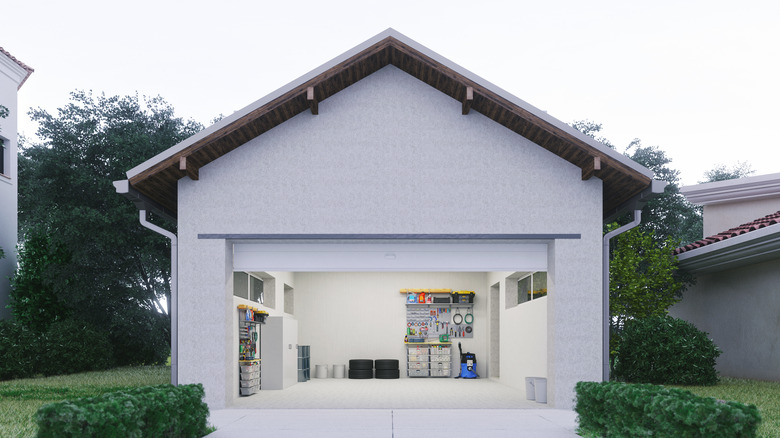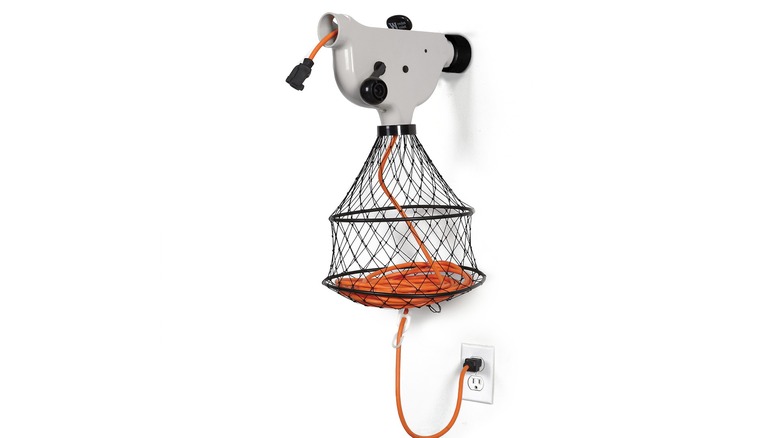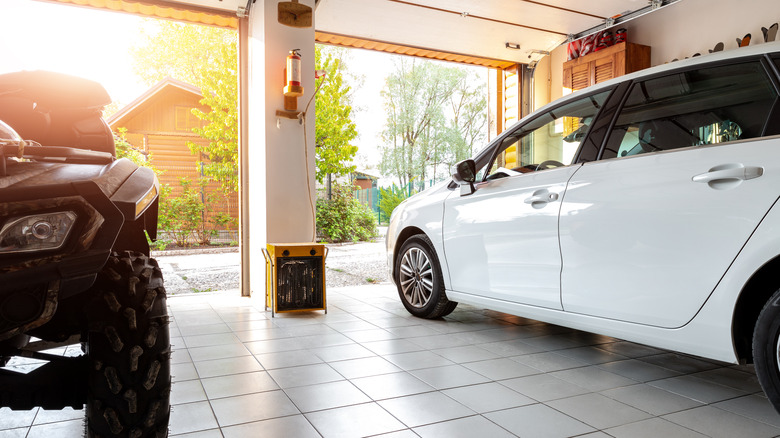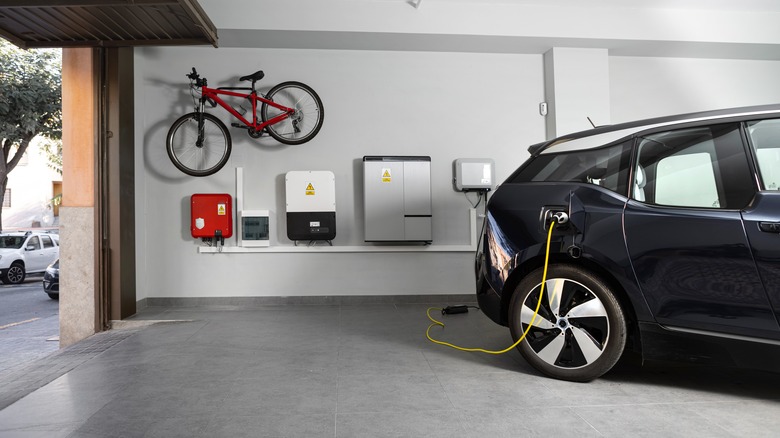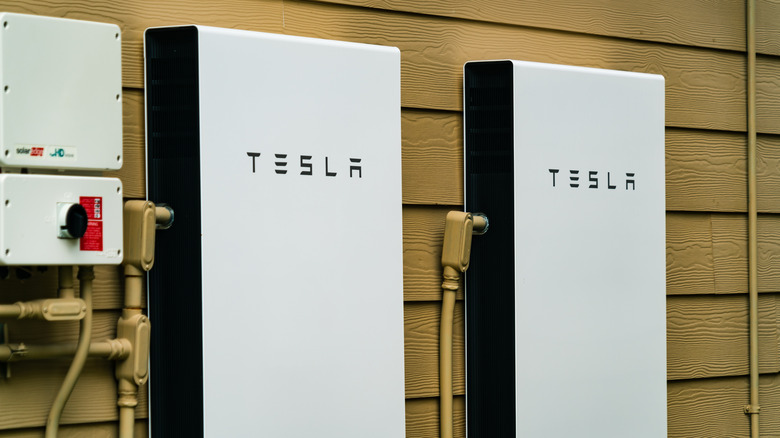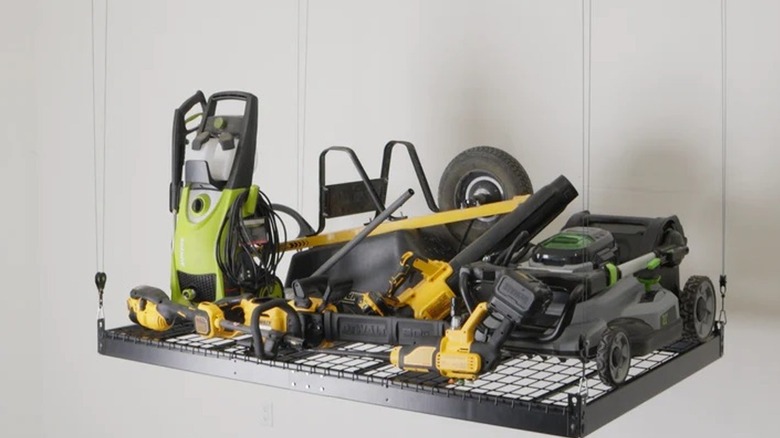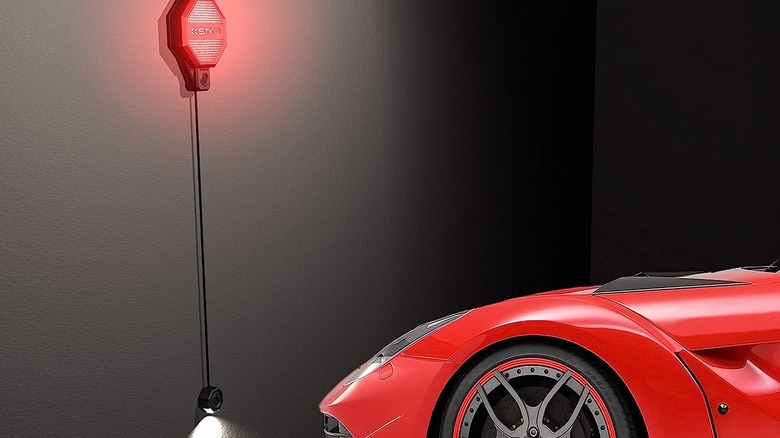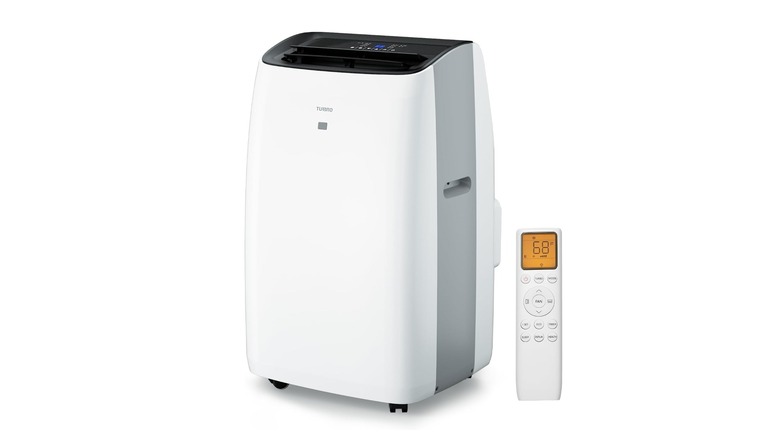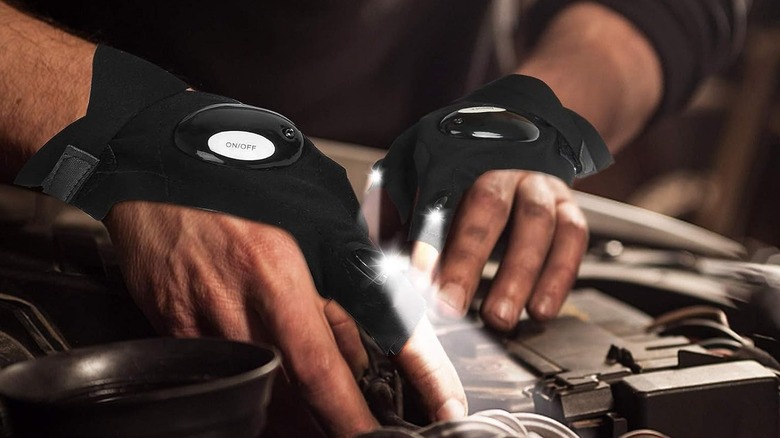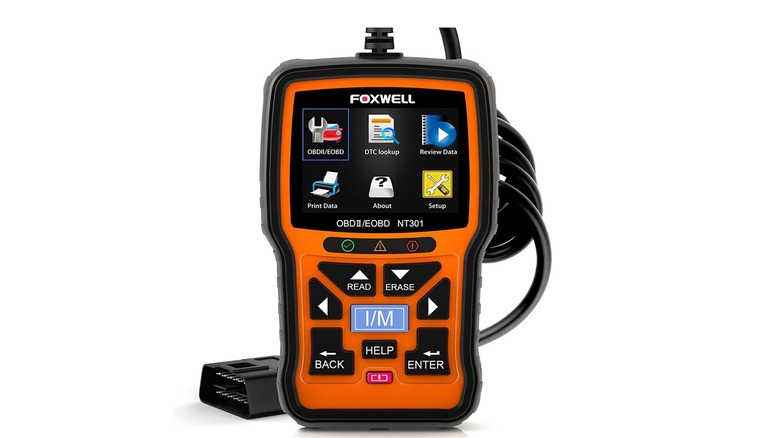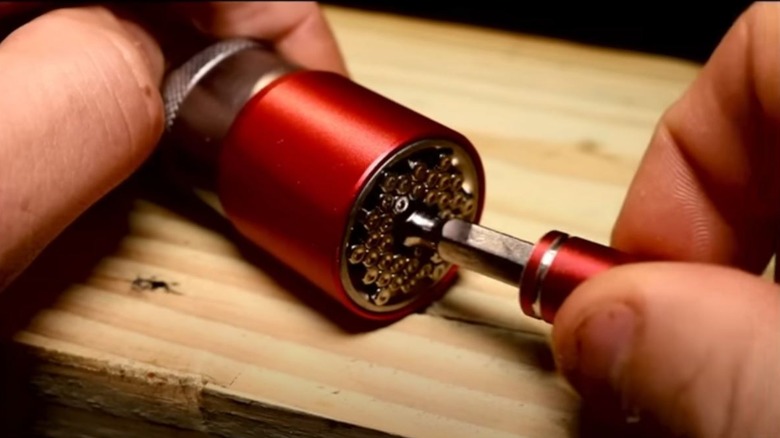10 Essential Gadgets You Should Have In Your Garage
You probably don't spend a lot of time thinking about your garage. For most of us, the garage is a liminal space that barely exists. It serves merely as a transitory point between being home and being someplace else, but it is capable of being so much more.
The traditional garage was intended as an automotive storage space, little more than a safe haven for your car when you're not using it. These spaces also tend to attract junk, with the garage being the final resting place for everything you don't really care about but haven't bothered to get rid of. For those reasons, the garage can be a place of some anxiety, if you even think about it at all.
There is, however, plenty of opportunity to turn your garage into more than a means of junk storage. Your garage could be, perhaps even should be, a useful addition to your home and a place where you enjoy spending time. You just need to trick it out with a few gadgets and accessories to take your concrete carriage cave to the next level. Here are some essential gadgets you should have in your garage.
Hand-cranked cord organizer
In addition to your vehicles, garages like to accumulate the odds and ends of life that don't have a home anywhere else. If you've got old photo albums or holiday decorations, they probably live in a box in the garage. More likely than not, they're sitting right next to your collection of seldom-used extension cords.
Extension cords are one of those weird possessions that are both highly useful and rarely needed. They're not the sort of thing you want to get rid of, because you're certain to need one in the medium term, but you also don't really want strewn about throughout your space. As a result, they often end up in a closet or out in the garage. Worst of all, by the time you need them they're inevitably tangled and impossible to work with. Things get even worse if you've made the mistake of throwing two cords in the same pile. That's where a cord organizer comes in handy.
The Wonder Winder mounts to your garage wall near an outlet and takes care of coiling your extension cords, so you don't have to. It can store up to 150 feet in the storage basket which hangs beneath the mechanism. Using your extension cord is as easy as plugging in and walking to your workstation. When you're ready to clean up, just turn the hand crank to coil it up.
Smart garage door opener
These days, practically all household objects are "smart" and connected to the internet. It wasn't long ago, however, when remote control of physical objects was a novel technology. For many, the garage door remote was one of the first remote control technologies you were likely to encounter. They work well enough, which is why most folks still have the same sorts of garage door openers they had 30 years ago.
If this describes your garage situation, it might be time for an upgrade. Fortunately, there's no need to completely replace your existing garage door opener. The myQ Smart Garage system is compatible with a wide range of garage doors, even most doors manufactured in the '90s.
Once installed, you'll be able to open or close your garage door from anywhere in the world with the connected smartphone app, provided you have an internet connection. You'll also never wonder if you remembered to close the garage door because you can get real-time status updates whenever you wish. The system is also compatible with Amazon Key, which grants delivery personnel temporary access to your garage, to safely stow your packages.
Charging station
It wasn't long ago that the notion of widely available electric vehicles seemed like a pipe dream. Now, you can't drive down to the corner store without seeing one. If you're one of the growing number of people who have switched to electric or are considering it, you're going to do a lot of charging at home.
EVs typically come with a charging cable that is compatible with any ordinary 120-volt electrical outlet. The charge rate is slow but non-negligible if you're plugging in to charge overnight or over the weekend. Depending on your EV's range, it could take dozens of hours to get to a full charge on an ordinary outlet. Nissan, for instance, reports a 2.5-day charge time for the Leaf at an ordinary outlet. Fortunately, that's only the beginning of at-home EV charging.
A dedicated charging station can offer level two charging, provided your home's electrical system can handle the load, reducing charge times considerably. That same Nissan Leaf on a level two charger can get from empty to full in as little as 7.5 hours. Moreover, dedicated charging stations often offer smart features like real-time updates on your charge level and predictions for when you'll be finished. Some even let you schedule charging sessions or pause them remotely, allowing you to charge only when electricity is most affordable in your area.
Home battery backup
For many people, access to electricity is ubiquitous, and perhaps even taken for granted. When something like a storm or natural disaster comes along and takes it away, it can be inconvenient at best and fatal at worst. For decades, the go-to solution for off-grid power was a gas generator. Loaded up with gasoline, a good generator can keep your house up and running for a good long while, but they aren't really suitable for running inside of your garage, what with the fumes and all.
As battery technologies improve, however, the option to keep battery backup instead of conventional gas generators is more accessible than ever. There are a number of large battery power banks available on the market and at a variety of price points depending on your needs.
The Delta Pro Portable Power Station from EF Ecoflow is easily portable and can store up to 75 ampere hours at full charge. With five outlets, you can plug in essentials like your refrigerator and run them for up to 48 hours. If you're looking for something more permanent and more integrated into your home, a Tesla Powerwall might be a good solution. The Powerwall is capable of taking power from solar panels or directly from the grid and storing that power for later use. Whatever you choose, you'll never regret having a little electricity on tap for an emergency.
Overhead storage
If you've had a garage for any significant amount of time, you've likely learned they're like black holes for clutter, grabbing hold of everything around them and tucking them into its darkest nooks and crannies. Over time, you're likely to accumulate more and more stuff in your garage, making it harder to park your car and threatening to pull your entire home into a singularity of stuff.
If you find that your garage is getting a little crowded, you could clear up some breathing room by going vertical. A garage hoist system allows you to have shelving that raises and lowers on command to keep miscellaneous stuff out of the way when you're not using it.
The Storage Lifter system from SmarterHome offers a 4-foot by 6-foot platform capable of holding up to 400 pounds, including the 60-pound frame. The platform uses four mechanical pulleys to lift your cargo between the floor, for easy loading, and the ceiling for storage. The pulleys sync automatically to ensure your platform always remains level, and you can control the whole thing from your smartphone via Bluetooth. If you've got the clearance, you could even mount the platform above your garage door, so that it's completely hidden from view when the garage door is open.
Parking assistant
Parking is a pain in the best of times, and squeezing into your garage can be stressful, particularly if you're driving something on the larger side. Getting your vehicle into the garage far enough for the door to close, but not so far that you hit something, is a constant struggle every time you come home.
There's always the tennis ball method, or you could place blocks on the ground to mark your stopping point. Both methods are tried and true, albeit a little low-tech. But this isn't your grandpa's garage, and you don't have to use your grandpa's methods. Proximity sensors are easily affordable and capable of telling you precisely when you've finished parking.
The parking sensor from STKR is typical of what you'll find on the market. The censor is straightforward, affordable, and gets the job done. It uses ultrasonic echolocation to measure the distance between the sensor and your vehicle. The first time you use it, you'll have to park the old-fashioned way, so it knows what you want. Place the sensor on your garage wall at bumper level and mount the signal light somewhere you'll be able to see it. Power it up with four AA batteries or by plugging it in with a USB cable and hitting the set key. Each time you park, the signal light will turn yellow when you're getting close and red when you've reached the right spot.
Portable AC / Heater
Garages aren't well known for their climate control. The walls are typically unfinished and uninsulated, and the floors are usually concrete. Worst of all, one entire wall is a thin metal door that opens directly onto the outside world. It isn't far removed from standing inside a literal cave, and, if you're in the heart of summer or the thick of winter, you're going to feel it.
Fortunately, garages are also typically relatively small spaces, making them suitable for portable coolers and heaters like a combo device from TURBRO. It works as both an air conditioner and a space heater for up to 600 square feet. That may not be enough to control the climate of your entire garage, but you don't really need to do that.
It comes with a 6-foot power cable and wheels, so you can cart it around to whatever corner of the garage you happen to be working in. If you've got a big job ahead of you and several hours of garage time to look forward to, knocking the temperature a few degrees in the right direction could make all the difference.
Flashlight gloves
If you spend a lot of time in the garage working on your car (or anything for that matter) you're probably intimately familiar with an irrational desire for more hands. With cars in particular, you're often working and trying to see in tight, poorly lit spaces. If you don't have an assistant, that could mean craning your body into awkward positions, reaching into cramped spaces, and wishing the whole time for a third hand while you hold a flashlight between your teeth.
Flashlight gloves won't give you a third hand, but they will free up a hand (or perhaps your mouth) by putting flashlights literally at your fingertips while keeping your hands free. Each glove has two LED flashlights, one at the thumb and one at the forefinger, each of which is powered individually by a watch battery.
The gloves themselves are breathable, waterproof, and don't cover your palms or fingertips, so you won't lose dexterity while wearing them. Since the lights are positioned at the tips of the thumb and forefinger, you will always have light where you need it.
Engine code reader
As long as you keep up with your car's regular maintenance, it should run exactly like it's supposed to. If you live in the real world, however, something is bound to go wrong with your car sooner or later. Outside of regular maintenance like oil changes, battery swaps, and fluid top-offs, the check engine light is one of the most common reasons you're likely to pop your head under the hood.
Frustratingly, all the check engine light really tells you is that something is wrong without being overly specific. Finding out what's wrong, or even what might be wrong, usually requires visiting a mechanic or at least stopping at your local auto shop to use their code reader.
Having a code reader of your own, in the garage, could save you a trip and let you know what parts you might need and what repairs might be needed before you start loosening bolts. The OBD2 Scanner from Foxwell not only provides you with the code you'll need but also gives you suggestions in plain language. It also records historical data in the event that you experience intermittent problems and need a record. The device can even connect to your printer, so you can print off the findings and take them with you to the shop.
Universal socket wrench
Can you ever really have enough socket wrenches? Personal experience would suggest you cannot. It seems like no matter how many sets you buy, you're always missing the one socket you need to get the job done. If you're tired of going to the hardware store to pick up yet another 10mm socket, it might be time for a universal solution.
These may not be the ideal solution for every single job, but a universal socket wrench will work in a pinch, and they can make some jobs (particularly those that require multiple socket sizes) considerably easier. The best way to understand how they work is to think of those pinscreen toys from when you were a kid. They were a block of plastic or metal pins you could press objects or perhaps even your face into.
Instead of flimsy pins, universal socket wrenches have robust metal pins that push inward. In that way, it can accept and manipulate objects of multiple shapes and sizes. The upshot is that you don't even need to know the right-sized wrench for the job. As long as the bolt you're turning is smaller than your wrench's maximum size, just jam it in there and start turning.
